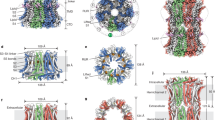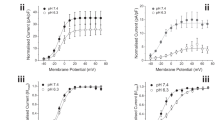Abstract
Haem is essential for living organisms, functioning as a crucial element in the redox-sensitive reaction centre in haemproteins1. During the biogenesis of these proteins, the haem cofactor is typically incorporated enzymatically into the haem pockets of the apo-haemprotein as the functionally indispensable prosthetic group2,3. A class of ion channel, the large-conductance calcium-dependent Slo1 BK channels, possesses a conserved haem-binding sequence motif. Here we present electrophysiological and structural evidence showing that haem directly regulates cloned human Slo1 channels and wild-type BK channels in rat brain. Both oxidized and reduced haem binds to the hSlo1 channel protein and profoundly inhibits transmembrane K+ currents by decreasing the frequency of channel opening. This direct regulation of the BK channel identifies a previously unknown role of haem as an acute signalling molecule.
This is a preview of subscription content, access via your institution
Access options
Subscribe to this journal
Receive 51 print issues and online access
$199.00 per year
only $3.90 per issue
Buy this article
- Purchase on Springer Link
- Instant access to full article PDF
Prices may be subject to local taxes which are calculated during checkout




Similar content being viewed by others
References
Granick, S. & Beale, S. I. Hemes, chlorophylls, and related compounds: biosynthesis and metabolic regulation. Adv. Enzymol. Relat. Areas Mol. Biol. 46, 33–203 (1978)
Daltrop, O., Allen, J. W., Willis, A. C. & Ferguson, S. J. In vitro formation of a c-type cytochrome. Proc. Natl Acad. Sci. USA 99, 7872–7876 (2002)
Ponka, P. Cell biology of heme. Am. J. Med. Sci. 318, 241–256 (1999)
Blackmon, B. J., Dailey, T. A., Lianchun, X. & Dailey, H. A. Characterization of a human and mouse tetrapyrrole-binding protein. Arch. Biochem. Biophys. 407, 196–201 (2002)
Hirotsu, S. et al. Crystal structure of a multifunctional 2-Cys peroxiredoxin heme-binding protein 23 kDa/proliferation-associated gene product. Proc. Natl Acad. Sci. USA 96, 12333–12338 (1999)
Taketani, S. et al. Molecular characterization of a newly identified heme-binding protein induced during differentiation of urine erythroleukemia cells. J. Biol. Chem. 273, 31388–31394 (1998)
Ricci, A. J., Gray-Keller, M. & Fettiplace, R. Tonotopic variations of calcium signalling in turtle auditory hair cells. J. Physiol. (Lond.) 524, 423–436 (2000)
ZhuGe, R. et al. Dynamics of signaling between Ca2+ sparks and Ca2+-activated K+ channels studied with a novel image-based method for direct intracellular measurement of ryanodine receptor Ca2+ current. J. Gen. Physiol. 116, 845–864 (2000)
Gribkoff, V. K. et al. Targeting acute ischemic stroke with a calcium-sensitive opener of maxi-K potassium channels. Nature Med. 7, 471–477 (2001)
Xu, W. et al. Cytoprotective role of Ca2+-activated K+ channels in the cardiac inner mitochondrial membrane. Science 298, 1029–1033 (2002)
Dore, S. Decreased activity of the antioxidant heme oxygenase enzyme: implications in ischemia and in Alzheimer's disease. Free Radic. Biol. Med. 32, 1276–1282 (2002)
More, C. et al. EPR spectroscopy: a powerful technique for the structural and functional investigation of metalloproteins. Biospectroscopy 5, S3–S18 (1999)
Brautigan, D. L. et al. Multiple low spin forms of the cytochrome c ferrihemochrome. EPR spectra of various eukaryotic and prokaryotic cytochromes c. J. Biol. Chem. 252, 574–582 (1977)
Jiang, Y. et al. Crystal structure and mechanism of a calcium-gated potassium channel. Nature 417, 515–522 (2002)
Worthington, M. T., Cohn, S. M., Miller, S. K., Luo, R. Q. & Berg, C. L. Characterization of a human plasma membrane heme transporter in intestinal and hepatocyte cell lines. Am. J. Physiol. 280, G1172–G1177 (2001)
Siemen, D., Loupatatzis, C., Borecky, J., Gulbins, E. & Lang, F. Ca2+-activated K channel of the BK-type in the inner mitochondrial membrane of a human glioma cell line. Biochem. Biophys. Res. Commun. 257, 549–554 (1999)
Yermolaieva, O., Tang, X. D., Daggett, H. & Hoshi, T. Calcium-activated mitochondrial K+ channel is involved in regulation of mitochondrial membrane potential and permeability transition. Biophys. J. 80, 950A (2001)
Shaklai, N., Shviro, Y., Rabizadeh, E. & Kirschner-Zilber, I. Accumulation and drainage of hemin in the red cell membrane. Biochim. Biophys. Acta 821, 355–366 (1985)
Tang, X. D. et al. Oxidative regulation of large conductance calcium-activated potassium channels. J. Gen. Physiol. 117, 253–274 (2001)
Acknowledgements
We thank L. Ciali for critically reading the manuscript; V. Avdonin and R. Wassef for help with constructing the mutants; and P. Angiolillo for use of the EPR spectrometer. This work was supported, in part, by the NIH and the American Heart Association.
Author information
Authors and Affiliations
Corresponding author
Ethics declarations
Competing interests
M. L. Garcia is an employee of Merck & Co. Inc. and potentially owns stock and/or holds stock options in the company.
Supplementary information
Rights and permissions
About this article
Cite this article
Tang, X., Xu, R., Reynolds, M. et al. Haem can bind to and inhibit mammalian calcium-dependent Slo1 BK channels. Nature 425, 531–535 (2003). https://doi.org/10.1038/nature02003
Received:
Accepted:
Issue Date:
DOI: https://doi.org/10.1038/nature02003
This article is cited by
-
Intracellular hemin is a potent inhibitor of the voltage-gated potassium channel Kv10.1
Scientific Reports (2022)
-
Heme controls the structural rearrangement of its sensor protein mediating the hemolytic bacterial survival
Communications Biology (2021)
-
Single channel properties of mitochondrial large conductance potassium channel formed by BK-VEDEC splice variant
Scientific Reports (2021)
-
Oxygen-dependent regulation of ion channels: acute responses, post-translational modification, and response to chronic hypoxia
Pflügers Archiv - European Journal of Physiology (2021)
-
Emerging Role of Microglia-Mediated Neuroinflammation in Epilepsy after Subarachnoid Hemorrhage
Molecular Neurobiology (2021)
Comments
By submitting a comment you agree to abide by our Terms and Community Guidelines. If you find something abusive or that does not comply with our terms or guidelines please flag it as inappropriate.



